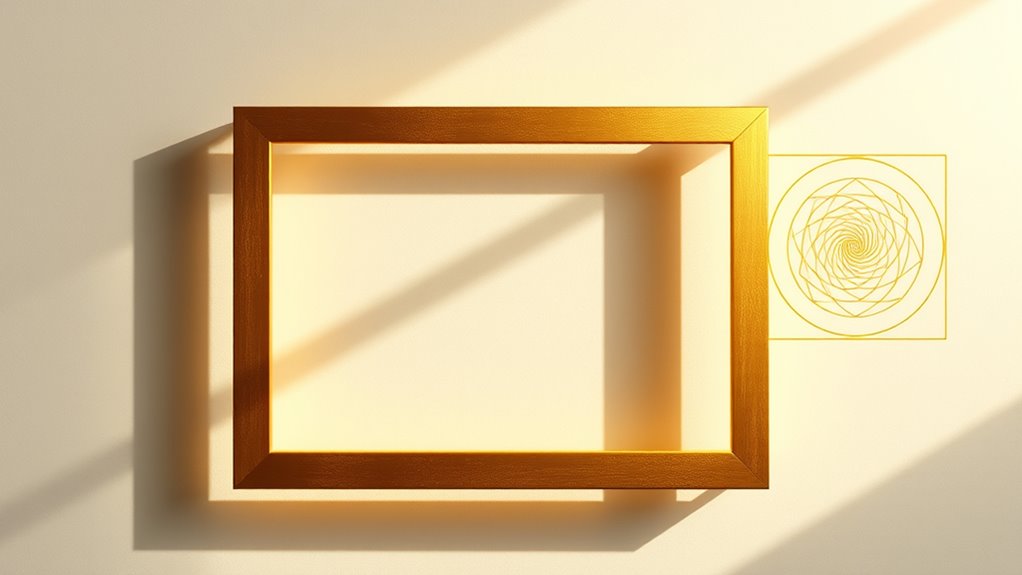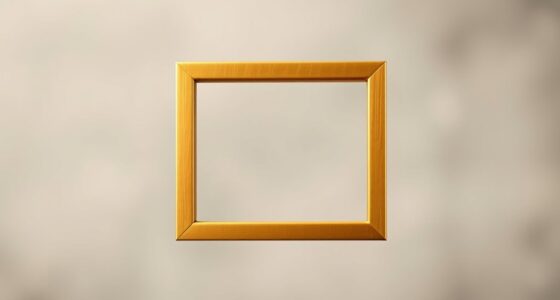The golden rectangle is a shape where the ratio of its longer side to its shorter side is about 1.618, known as the golden ratio. This special proportion appears in nature, art, and architecture, creating a sense of harmony and beauty. It’s connected to the Fibonacci sequence, which demonstrates how natural growth follows this divine proportion. If you keep exploring, you’ll discover how this elegant shape influences design and natural forms around us.
Key Takeaways
- A golden rectangle has sides in the ratio approximately 1.618, creating a sense of harmony and balance in design.
- Removing a square from a golden rectangle produces a similar, smaller golden rectangle, illustrating its self-similarity.
- The ratio is linked to the Fibonacci sequence, with successive ratios approaching 1.618 as numbers increase.
- Natural forms like seashells and sunflower heads display Fibonacci spirals aligned with the golden ratio.
- Artists and architects use the golden rectangle to achieve aesthetically pleasing compositions and structures.

The golden rectangle is a fascinating geometric shape that has captivated artists, architects, and mathematicians for centuries. Its defining feature is that when you remove a square from it, the remaining rectangle is similar to the original. This property creates a sense of balance and harmony that many consider aesthetically pleasing. At the core of this shape lies the concept of divine proportions, often associated with beauty and natural order. The ratio of the longer side to the shorter side of a golden rectangle is approximately 1.618, known as the golden ratio. This ratio isn’t just a random number; it appears repeatedly in nature, art, and architecture, inspiring countless works and designs. Additionally, the golden rectangle’s unique proportions are often used in visual composition to create balanced and harmonious visuals.
One of the most intriguing aspects of the golden rectangle is its connection to the Fibonacci sequence. This sequence starts with 0 and 1, and each subsequent number is the sum of the previous two. As the Fibonacci numbers grow larger, their ratio approaches the golden ratio. This means that if you take successive Fibonacci numbers, their ratios get closer and closer to 1.618. When you construct rectangles using these Fibonacci numbers, they approximate the golden rectangle more and more accurately as the numbers increase. This relationship shows how the divine proportions are embedded in natural growth patterns, giving the shape a sense of organic harmony.
Understanding the properties of the golden rectangle helps you appreciate why it appears so often in nature and human creations. For instance, seashells, sunflower heads, and pinecones all display Fibonacci spirals that align with the divine proportions. In architecture, structures like the Parthenon and modern designs incorporate these ratios to evoke balance and visual appeal. Artists, from Leonardo da Vinci to Salvador Dalí, have used the golden rectangle and the divine proportions to create compositions that feel naturally pleasing. The Fibonacci sequence offers a mathematical explanation for why these proportions resonate so deeply—they mirror the way living organisms grow and develop.
Frequently Asked Questions
How Is the Golden Ratio Related to the Fibonacci Sequence?
The golden ratio is closely related to the Fibonacci connection through their numerical relationship. As you progress along the Fibonacci sequence, dividing each number by its predecessor, the ratio approaches the golden ratio (~1.618). This convergence shows a fascinating link between the sequence and the ratio, highlighting how the Fibonacci sequence naturally embodies the proportions found in the golden rectangle and other aesthetic elements.
Can the Golden Rectangle Be Found in Modern Architecture?
Yes, you can find the golden rectangle in modern buildings, often used to enhance architectural aesthetics. Architects incorporate this proportion to create visually pleasing designs, balancing harmony and elegance. Iconic structures like museums, skyscrapers, and public spaces often feature golden rectangles in their facades or layouts. When you observe these buildings, you’ll notice the subtle yet powerful influence of the golden ratio, making the architecture more appealing and harmonious.
What Are the Common Misconceptions About the Golden Rectangle?
You might think misconceptions myths and inaccurate beliefs about the golden rectangle are all true, but that’s not the case. Some believe it’s a strict rule for perfect design, yet it’s more of a guiding principle than an absolute. Others assume it’s only in ancient architecture, ignoring its presence in modern designs. Recognizing these misconceptions helps you appreciate the golden rectangle’s true role in both art and architecture.
How Does the Golden Rectangle Influence Art and Design?
You can see that the golden rectangle influences art and design by creating proportional harmony that appeals to the eye. Artists and designers often use its ratios to craft visually balanced compositions, ensuring aesthetic appeal. By incorporating the golden rectangle, you achieve a sense of natural elegance and order, making your work more engaging and harmonious. It’s a powerful tool for enhancing the beauty and effectiveness of your creative projects.
Are There Any Natural Occurrences of the Golden Rectangle?
Like a hidden secret woven into nature’s tapestry, the golden rectangle appears in many natural formations and biological structures. You’ll find it in the spiral shells of mollusks, the branching of trees, and the arrangement of sunflower seeds. These natural occurrences mirror the divine harmony of the golden rectangle, revealing how nature instinctively follows this timeless pattern, guiding growth and form with its elegant proportions.
Conclusion
Don’t think the golden rectangle is just a math curiosity. Its timeless beauty is everywhere—from art to architecture—and it’s easier to see once you understand its properties. Even if you’re not into math, you’ll appreciate how this simple shape creates harmony and balance in design. Next time you see a building or painting, look for the golden rectangle—you might be surprised at how often it appears, adding a touch of perfection to our world.









